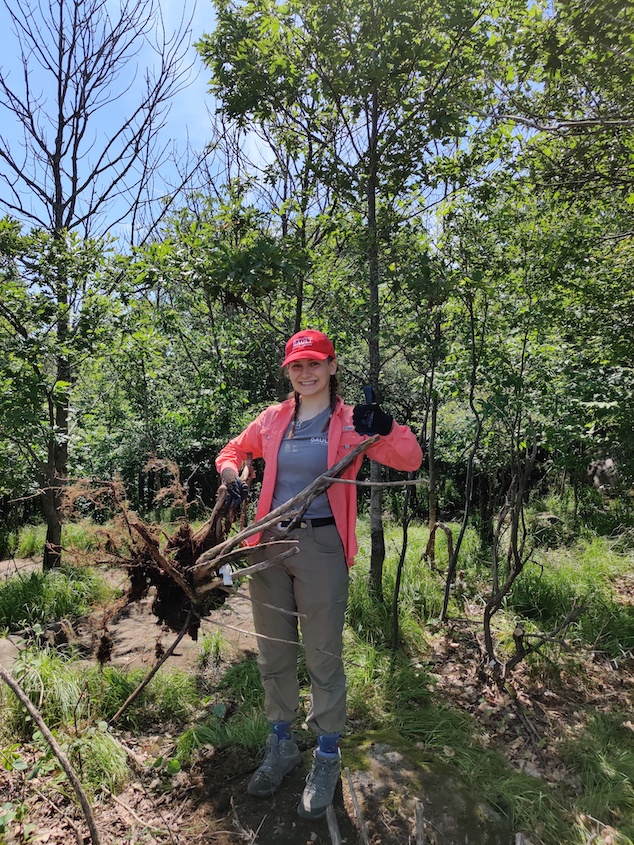Invasive species are non-native organisms that have been introduced to a new environment, often through human activity. Like most urban-adjacent parks, some areas of the Gault Nature Reserve are host to a few non-native plant species. This is why, every year, there are ongoing efforts to lessen the impact of these types of plant invasions on the rest of the ecosystem.
Over the past several years, interns have developed protocols that detail identification and removal strategies. This year’s interns are building upon that working knowledge and contributing to long-term removal efforts. This critical work is accomplished in two main steps: First, by identifying and mapping the location of invasive species patches and second, by removing the invasive plants using the appropriate techniques for each species.

Olivia, an intern this summer, holding the roots of a honeysuckle bush (photo: Philippe Hamel)
Why should invasive species be controlled?
Invasive species can damage their new surroundings and negatively impact the well-being of native organisms. For instance, certain introduced invasive species can outcompete native species, thus threatening their survival. This can, in turn, compromise ecosystem health, reduce biodiversity, and alter other organisms’ viable habitats.
A global phenomenon
You may have guessed it already, invasions by non-native species are not restricted to urban or peri-urban parks like Gault Nature Reserve; they are a global occurrence. Invasive species can even be found in your very own garden! Invasive plant species often go unnoticed by the untrained eye and are usually left untouched or even accidentally planted because they look nice or are hardy.
There are currently six invasive species known to be present at the Reserve:
- Eurasian watermilfoil (Myriophyllum spicatum)
- Garlic mustard (Alliaria petiolate)
- Honeysuckles (Lonicera sp.)
- Japanese knotweed (Reynoutria japonica)
- Phragmites (Phragmites australis)
- Purple loosestrife (Lythrum salarica)
Rest assured, a few tips and tricks can help identify and control these invaders. Our team has been trying some of these techniques throughout the summer. Although some are very simple, they can help reduce the impact of invasive species on the rest of the ecosystem. Each one of these species presents its own unique impacts and challenges, so our Field Operations Assistants are tailoring removal protocols for each species to be used at Gault.
Step 1. Identification
Identifying plants is no easy feat. Many plants look alike, which can be misleading. For example, the native common blue violet (Viola sororia) and the invasive garlic mustard look alike and are often confused. However, they can be differentiated using their scent: Garlic mustard leaves will have a garlic-like odour, whereas common violets’ leaves will not. After being trained by experts in identifying invasive species, the Field Operations Assistants now practice these types of identification techniques in the field regularly.
However, not everyone has access to these types of lessons, so apps that use artificial intelligence for species identification, such as iNaturalist, can provide a good starting point for amateurs who want to recognize invasive plants.

Garlic mustard has white flowers and leaves that smell of garlic (photo: Tony Atkins)
Step 2. Removal
Once an invasive species has been identified, the next step is to remove it using the correct method.

Morgane, an intern this summer, cuts phragmites to help control the spread of this invasive plant (photo: Niamh Stafford)
There are many ways to remove an invasive plant species. Sometimes, more than one technique is recommended, each with their degree of success. Herbicides are effective at eradicating unwanted plants, but this method can be harmful to the environment. So, at Gault, we choose to use other techniques like pruning, hand-pulling, and flooding to remove invasive species. Although more time-consuming, these methods are less likely to impact surrounding flora and fauna. For example, invasive phragmites, an invasive aquatic plant, can be removed by cutting the stems underwater. This technique, also known as “cut-to-drown”, will cut off the plant’s oxygen supply, essentially killing it. Some species will be very resilient to removal efforts and may require multiple intervention rounds. Being persistent will pay off in the end!
Invasive plant management is a learning process, and the interns are discovering more each time they go onto the field. Most importantly, they’ve seen firsthand that invasive plants can damage native ecosystems and why this work is necessary. The interns are encouraged by the positive impact they’ve had so far and aim to continue removing invasive species for the rest of the summer.
Niamh Stafford
Field Operations Assistant
Gault Nature Reserve of McGill University
Header: Alexandra Friedman, who interned at Gault in 2018, removes invasive phragmites (Phragmites australis) from the shore Lac Hertel (photo: Alex Tran)
Related articles
Invasive Species: A Study of Tench and Their Invasion Potential
August 4, 2022. To understand the potential impact that Tench might have on the Great Lakes Basin, McGill Ph.D. student Sunci Avlijaš conducted a study in 2018 examining the effects that temperature and type of lake environment have on Tench growth.



